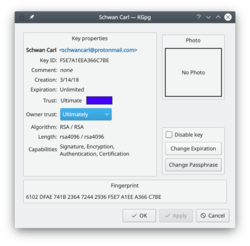KGpg/zh-tw: Difference between revisions
mNo edit summary |
Updating to match new version of source page |
||
| (16 intermediate revisions by 2 users not shown) | |||
| Line 1: | Line 1: | ||
<languages /> | <languages /> | ||
__TOC__ | |||
{|style="text-align:center" | {|style="text-align:center" | ||
|[[Image:Kgpg-keymgr.png|250px]]|| ||'''KGpg為gpg命令提供了圖形介面''' | |[[Image:Kgpg-keymgr.png|250px]]|| ||'''KGpg為gpg命令提供了圖形介面''' | ||
| Line 8: | Line 9: | ||
'''GnuPG'''加密和解密你的郵件和選定的文件。完成這樣的操作需要很多的命令選項。有了'''KGpg'''憂慮就可以消除了-你不再需要記住任何命令。 '''KGpg'''幫你建立和管理你密鑰,導入和導出密鑰,查看密鑰簽名,信任等級和有效期。實際上差不多所有你需要做的事情 '''KGpg'''都覆蓋到了。同時也提供嚮導幫助你建立你的密鑰。 | '''GnuPG'''加密和解密你的郵件和選定的文件。完成這樣的操作需要很多的命令選項。有了'''KGpg'''憂慮就可以消除了-你不再需要記住任何命令。 '''KGpg'''幫你建立和管理你密鑰,導入和導出密鑰,查看密鑰簽名,信任等級和有效期。實際上差不多所有你需要做的事情 '''KGpg'''都覆蓋到了。同時也提供嚮導幫助你建立你的密鑰。 | ||
<div class="mw-translate-fuzzy"> | |||
'''KGpg'''集成在[[Konqueror|Konqueror]]和[[Dolphin|Dolphin]]裡,這2個程序的右鍵關聯菜單允許你選擇簽名和不簽名情況下加密文件。 | '''KGpg'''集成在[[Konqueror|Konqueror]]和[[Dolphin|Dolphin]]裡,這2個程序的右鍵關聯菜單允許你選擇簽名和不簽名情況下加密文件。 | ||
{| | {| | ||
|[[Image:Kgpg-props.png|thumb|250px|查看一個密鑰的屬性]]|| ||[[Image:Kgpg-options.png|thumb|250px|右擊密鑰查看選項]] | |[[Image:Kgpg-props.png|thumb|250px|查看一個密鑰的屬性]]|| ||[[Image:Kgpg-options.png|thumb|250px|右擊密鑰查看選項]] | ||
|} | |} | ||
</div> | |||
== Extending the life of your keys == | |||
As you can see in the image above, you can extend the life of your keys using the <menuchoice>Change Expiration</menuchoice> button. Simply choose the new date from the popup calendar. To do this, however, you must have access to the private key and its pass-phrase. Without them you can do nothing. | |||
== Change your passphrase == | |||
Should you suspect your passphrase is compromised, you can change this also from the '''Key Properties''' dialogue. The <menuchoice>Change Passphrase</menuchoice> button is below <menuchoice>Change Expiration</menuchoice>. | |||
== Revoking a key == | |||
If you lose your private key or think it has been compromised in some way you need to revoke it. To reliably render a key unusable you need to revoke it. Revoking is done by adding a special revocation signature to the key. | |||
The revocation signature can be created together with the key. In this | |||
case it is stored in a separate file. This file can later be imported into | |||
the keyring and is then attached to the key rendering it unusable. | |||
{{Warning|1=Please note that to import this signature to the key no password is required. Therefore you should store this revokation signature in a safe place, usually one that is different from you key pair. It is a good advise to use a place that is detached from your computer, either copy it to an external storage device like an USB stick or print it out.}} | |||
If you have not created such a detached revocation on key creation you can | |||
create such a revocation signature at any time choosing <menuchoice>Your Key -> Revoke key</menuchoice>, optionally importing it to your keyring immediately. | |||
{{Note|1=The option to revoke a key has only been available in the context menu until KDE SC 4.7.1. Since then it has been moved to the key menu. }} | |||
<div class="mw-translate-fuzzy"> | |||
::{{Tip_(zh_TW)|如果你啟動的 '''KGpg'''是默認配置的話,它是會隱藏到系統托盤 中。要是你啟動後找不到該程序的窗口,請展開[[Plasma|Plasma]] 的系統托盤找找。 }} | |||
</div> | |||
{{Tip|1=If a contact has more than one key - perhaps some old keys in addition to the current one - and the wrong key is being used for encryption, find the old keys and reduced their Trust status to Not Trusted. They will remain available for decrypting old messages, but not used for new ones. }} | |||
<div class="mw-translate-fuzzy"> | |||
這份''[http://docs.kde.org/development/en/kdeutils/kgpg/index.html 完整的說明手冊]''有助於你了解每個細節。 | |||
</div> | |||
<div class="mw-translate-fuzzy"> | |||
要是你沒能力現實的驗證聯繫人的身份,你應該讀讀''[http://docs.kde.org/development/en/kdeutils/kgpg/manage.html#keysigning 密鑰簽名部分]''了解本地簽名的益處。 | |||
</div> | |||
== Tutorials == | |||
* [https://peertube.mastodon.host/videos/watch/bc82c21b-7526-44be-8efb-ede6edac51af Verify GPG signatures with KGpg inside Dolphin] (Source Peertube instance: peertube.mastodon.host) | |||
== More Information == | |||
* [[Special:myLanguage/Concepts/OpenPGP_For_Beginners|Explanation of OpenPGP concepts for beginners]] | |||
* [https://www.gnupg.org/documentation/howtos.en.html The base software: GnuPG] | |||
* [https://docs.kde.org/stable5/en/kdeutils/kgpg/index.html '''KGpg''' manual] | |||
[[Category:工具 | <div class="mw-translate-fuzzy"> | ||
[[Category:安全 | [[Category:工具/zh-tw]] | ||
[[Category:安全/zh-tw]] | |||
</div> | |||
Latest revision as of 11:15, 1 August 2019
 |
KGpg為gpg命令提供了圖形介面 |
GnuPG加密和解密你的郵件和選定的文件。完成這樣的操作需要很多的命令選項。有了KGpg憂慮就可以消除了-你不再需要記住任何命令。 KGpg幫你建立和管理你密鑰,導入和導出密鑰,查看密鑰簽名,信任等級和有效期。實際上差不多所有你需要做的事情 KGpg都覆蓋到了。同時也提供嚮導幫助你建立你的密鑰。
Extending the life of your keys
As you can see in the image above, you can extend the life of your keys using the button. Simply choose the new date from the popup calendar. To do this, however, you must have access to the private key and its pass-phrase. Without them you can do nothing.
Change your passphrase
Should you suspect your passphrase is compromised, you can change this also from the Key Properties dialogue. The button is below .
Revoking a key
If you lose your private key or think it has been compromised in some way you need to revoke it. To reliably render a key unusable you need to revoke it. Revoking is done by adding a special revocation signature to the key.
The revocation signature can be created together with the key. In this case it is stored in a separate file. This file can later be imported into the keyring and is then attached to the key rendering it unusable.
If you have not created such a detached revocation on key creation you can
create such a revocation signature at any time choosing , optionally importing it to your keyring immediately.
這份完整的說明手冊有助於你了解每個細節。
要是你沒能力現實的驗證聯繫人的身份,你應該讀讀密鑰簽名部分了解本地簽名的益處。
Tutorials
- Verify GPG signatures with KGpg inside Dolphin (Source Peertube instance: peertube.mastodon.host)





